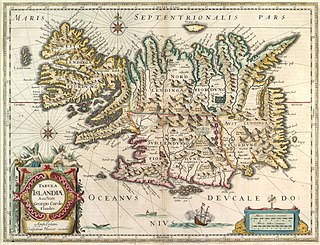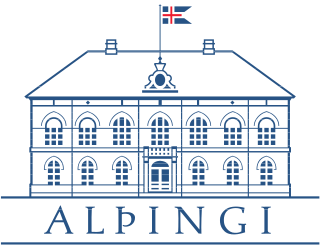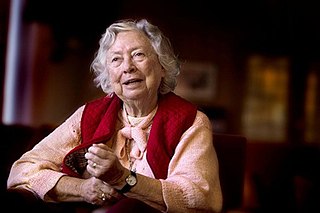
The recorded history of Iceland began with the settlement by Viking explorers and the people they enslaved from Western Europe, particularly in modern-day Norway and the British Isles, in the late ninth century. Iceland was still uninhabited long after the rest of Western Europe had been settled. Recorded settlement has conventionally been dated back to 874, although archaeological evidence indicates Gaelic monks from Ireland, known as papar according to sagas, may have settled Iceland earlier.

The Alþingi, anglicised as Althingi or Althing, is the supreme national parliament of Iceland. It is one of the oldest surviving parliaments in the world. The Althing was founded in 930 at Þingvellir, situated approximately 45 kilometres (28 mi) east of what later became the country's capital, Reykjavík. After Iceland's union with Norway in 1262, the Althing lost its legislative power, which was not restored until 1903 when Iceland gained Home Rule from Denmark. For 641 years, the Althing did not serve as the parliament of Iceland, ultimately power rested with the Norwegian, and subsequently the Danish throne. Even after Iceland's union with Norway in 1262, the Althing still held its sessions at Þingvellir until 1800, when it was discontinued. It was restored in 1844 by royal decree and moved to Reykjavík. The restored unicameral legislature first came together in 1845 and after 1874 operated in two chambers with an additional third chamber taking on a greater role as the decades passed until 1991 when Althing became once again unicameral. The present parliament building, the Alþingishús, was built in 1881, made of hewn Icelandic stone. The unicameral parliament has 63 members, and is elected every four years based on party-list proportional representation. The current speaker of the Althing is Birgir Ármannsson.

The Saga of Erik the Red, in Old Norse: Eiríks saga rauða, is an Icelandic saga on the Norse exploration of North America. The original saga is thought to have been written in the 13th century. It is preserved in somewhat different versions in two manuscripts: Hauksbók and Skálholtsbók.

The Church of Iceland, officially the Evangelical Lutheran Church of Iceland, is the national church of Iceland. The church is Christian and professes the Lutheran faith. It is a member of the Lutheran World Federation, the Porvoo Communion, the Communion of Protestant Churches in Europe, and the World Council of Churches.

Goðafoss is a waterfall in northern Iceland. It is located along the country's main ring road at the junction with the Sprengisandur highland road, about 45 minutes from Akureyri. The water of the river Skjálfandafljót falls from a height of 12 metres over a width of 30 metres. A 1.8-mile hiking trail loops around the waterfall area.

Old Norse religion, also known as Norse paganism, is a branch of Germanic religion which developed during the Proto-Norse period, when the North Germanic peoples separated into a distinct branch of the Germanic peoples. It was replaced by Christianity and forgotten during the Christianisation of Scandinavia. Scholars reconstruct aspects of North Germanic Religion by historical linguistics, archaeology, toponymy, and records left by North Germanic peoples, such as runic inscriptions in the Younger Futhark, a distinctly North Germanic extension of the runic alphabet. Numerous Old Norse works dated to the 13th-century record Norse mythology, a component of North Germanic religion.

Íslendingabók is a historical work dealing with early Icelandic history. The author was an Icelandic priest, Ari Þorgilsson, working in the early 12th century. The work originally existed in two different versions but only the younger one has survived. The older contained information on Norwegian kings, made use of by later writers of kings' sagas.

Kings' sagas are Old Norse sagas which principally tell of the lives of semi-legendary and legendary Nordic kings, also known as saga kings. They were composed during the twelfth through the fourteenth centuries, primarily in Iceland, but with some written in Norway.
Thorgeir Ljosvetningagodi Thorkelsson was a lawspeaker in Iceland's Althing from 985 to 1001.

Landvættir are spirits of the land in Old Nordic religion, later folk belief and modern Heathenry. They are closely associated with specific locations and their wellbeing is presented as being required for the land they inhabit to be fruitful. In Old Norse sources, they are depicted as being potentially harmful and capable of driving away unwanted individuals and capable of being frightened through human actions such as usage of carved figureheads on ships or níðstangs. Good relationships between humans and landvættir were believed to be fostered through acts like leaving out food for them however upon the establishment of the church, the practice was labelled heretical and explicitly forbidden in the Norwegian Gulating law codes.
Víga-Glúms saga is one of the Sagas of Icelanders. It takes place mostly in and around Eyjafjörður in North Iceland, and recounts the life and fall of Glúmr Eyjólfsson, a powerful man whose nickname, Víga, refers to his propensity for killing people. It is believed to have been written in the first half of the 13th century and one passage may allude to a political scandal of that time.
Religion in Iceland has been predominantly Christianity since its adoption as the state religion by the Althing under the influence of Olaf Tryggvason, the king of Norway, in 999/1000 CE. Until then, in the 9th and 10th centuries, the prevailing religion among the early Icelanders — who were mostly Norwegian settlers fleeing Harald Fairhair's monarchical centralisation in 872–930, with some Swedes and Norse British settlers — was the northern Germanic religion, which persisted for centuries even after the official Christianisation of the state.
Ari Þorgilsson was Iceland's most prominent medieval chronicler. He was the author of Íslendingabók, which details the histories of the various families who settled Iceland. He is typically referred to as Ari the Wise, and according to Snorri Sturluson was the first to write history in Old Norse.
Þangbrandr was a missionary sent to Iceland by king of Norway Óláfr Tryggvason to convert the inhabitants to Christianity. Snorri Sturluson described him as follows:
Hænsa-Þóris saga is one of the sagas of Icelanders.

The history of Christianity in Iceland can be traced back to the Early Middle Ages when Irish hermits settled in Iceland, at least a century before the arrival of the first Norse settlers in the 870s. Christianity started to spread among the Icelanders at the end of the 10th century. The adoption of the new faith by the whole population was the consequence of a compromise between the Christian and heathen chieftains, as well as the lawspeaker, at the national assembly or Alþingi of 999 or 1000.
Thorvald Konradsson the Far Traveller was one of the first Christian missionaries in Iceland and then in Belarus in the late 10th century. He was native to Iceland but went abroad where he was baptized by one Bishop Friedrich, a German. He returned to the island in Bishop Friedrich's retinue in 981. They were especially active in proselytising among the inhabitants of the northern parts of Iceland. However, Thorvald killed two men in a battle and was expelled from the island in 986.
Stefnir Thorgilsson was one of the first Christian missionaries among the Icelanders at the end of the 10th century. He was born in Iceland. King Olaf Tryggvason, king of Norway ordered him to return to his homeland in order to proselytize among the Icelanders. He destroyed a number of heathen temples and idols, for which he was expelled from the island.
The Tale of Thorstein Shiver is an Icelandic þáttur about the conversion of the Nordic countries to Christianity. The þáttur tells the humorous tale of Thorstein Thorkelsson's encounter with a demon and how he earns his nickname. The þáttur is contained in the Flateyjarbók. The story's status as a þáttur has been questioned.

Ólafía Einarsdóttir was an Icelandic archaeologist and historian, specialising in Icelandic chronology. She was the first Icelander to complete a degree in archaeology. After completing her PhD from Lund University in 1964, she taught at the University of Copenhagen and published many works about Icelandic sagas and Viking history.
















